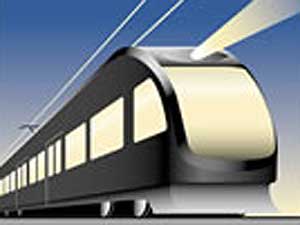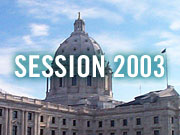Audio
Photos
More from MPR
Resources
Your Voice
| |||||||||||||||||||||||||||||||||||||||||||||||||||||||
Pawlenty: State shouldn't pay for LRT operation
February 20, 2003
 |
| The Hiawatha light rail line between downtown Minneapolis and the Mall of America is scheduled to begin operations next year. (Image courtesy of Hiawatha project) |
Minneapolis, Minn. — It'll cost about $16 million a year to run the Hiawatha light rail service when it's finished. The line will be owned and operated by Metro Transit, a division of the Metropolitan Council.
 | |||
Peter Bell, appointed by Gov. Tim Pawlenty a month ago as the new chair of the Met Council, says state taxpayers have done their share in paying for transit service that will benefit mainly Minneapolis.
"We're asking that local municipalities -- Hennepin County and Minneapolis principally, that will be the primary beneficiaries of light rail -- that they pay 60 percent of the operating costs of light rail system. The state of Minnesota would pick up the remaining 40 percent," says Bell. "We think this is reasonable, particularly in light of the state contribution to the capital cost of the system. We put more than $120 million into capital costs."
Light rail supporters say the governor's plan changes an agreement the state would pay the LRT's operating costs. Sam Grabarski, the president of the Minneapolis Downtown Council, a private group whose members are the city's largest employers, says the governor's proposal is bad public policy.
|
We think this (40 percent state share) is reasonable, particularly in light of the state contribution to the capital cost of the system. We put more than $120 million into capital costs.
- Met Council Chairman Peter Bell |
Grabarski says light rail opponents argue the line is mainly an economic development tool for Minneapolis, but fail to apply the same reasoning to roads -- whose costs are borne by state taxpayers.
"I can't think of a single road that's been built in Minnesota for years and years -- decades for that matter -- that wasn't built solely for economic purposes. And all the road building going forward is for economic purposes," says Grabarski.
Met Council chairman Peter Bell says state officials struggled to win even the 40 percent proposed operating support for light rail.
"There are elements in the state that think the state should not put any more in, and that we've done our share with our contributions to the capital costs," Bell says.
Hard feelings, a tight budget and lack of a metro transit tax help explain the latest light rail money spat. Some lawmakers still feel they were snookered by the deal brokered during former Gov. Jesse Ventura's administration to use state funds to help build the system. Others don't want transit spending to in any way jeopardize money available for road building.
Hennepin County Commissioner Peter McLaughlin says the situation is exacerbated because the Twin Cities does not have a dedicated source of transit funding.
 | |||
"We are one of the few major metropolitan areas in the country where there is not some sort of metro-wide, non-property tax in place to provide much of the operating cost of the transit system," says McLaughlin. "There are sales taxes of various sizes in most of the metropolitan areas around the country that are dedicated to the transit system."
Planners once envisioned three Twin Cities light rail lines. The service proposed for St. Paul along the river to the airport is off the table, and an express bus service offered as a replacement has run into neighborhood opposition. A light rail line between the two downtowns along University Ave. is in early planning stages and years away from development.
The Hiawatha line opens for limited service in about a year, with full service connecting downtown Minneapolis with the airport and the Mall of America by fall 2004.
|
News Headlines
|
Related Subjects
|

